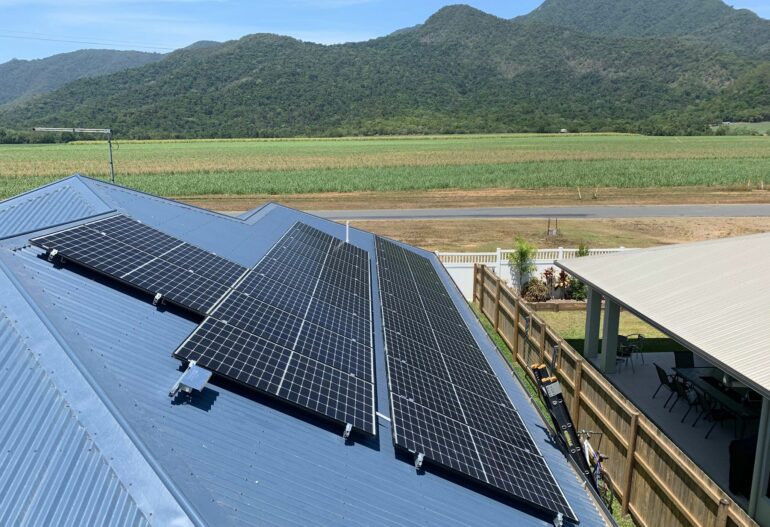Introduction
Cairns Electricity Cost Calculator
Is it always higher than expected? A common question among our clients is, ‘Why is my power bill so high’? Well, if this is you, always frowning whenever you see your electricity bill, cheer up, we are here to put a smile back on your face—next month, actually!
Electricity bills are increasingly becoming a major cost for most Australian households. The first step to reducing your energy cost is therefore to understand the factors that determine your overall electricity bill, and identify the main culprits behind your high energy consumption rate.
Hint: Your appliances are a significant contributor to your high power bills.
Of course, this varies from household to household depending on energy usage habits and appliance models used. Look at the appliances in your home, what are their energy efficiency rates?
While you may be aware of the main electricity suckers in your home, many do not truly know how much energy these appliances consume. By arming yourself with relevant knowledge, you’ll gain power over your consumption habits and make right decisions when purchasing appliances; ultimately saving money on subsequent electricity bills.
As a general guide, this well-researched article has evaluated various household appliances and the results are surprising!
In the context of rising electricity prices, it certainly pays to consider your energy needs and make the right decision when purchasing your appliances. Read to the end and thank us later!
On this page
How It Works
How Does The Electricity Cost Calculator Work?
This power cost calculator is designed to estimate both the energy consumption and annual running cost of an appliance. The only information you need to feed it with is:
1) The amount of power your appliance draws in Watts. This information is available on most compliance plates, as shown below. For enhanced accuracy, use an energy monitor or plug-in power meter (for large appliances).
2) The electricity tariff in cents per kilowatt. This tariff is indicated on your electricity bill. Enter 25 in case you don’t have your bill.
3) An estimate of how often the appliance is used.
Power Draw in watts:


Mike and Jan Cairns
Cairns, QLDA fantastic job by the team worked so hard and finally cleaned up so well that you would not know that they had been there. Overall I could not be more satisfied with the service I received from every member if the Hielscher Electrical team and would be happy the recommended them to any one looking for a solar system installer.

Energy and Money Saving Solutions
Hielscher Electrical work with Queensland's leading wholesalers and like us, they are committed to delivering the highest quality solar power components.

5 Stars Customer Service
Our customers are our business and that's why Hielscher Electrical and Solar are committed from start to finish.


Electricity Cost Calculator
Appliance Electricity Cost Calculator
What You Need to KNow
What You Need To Know When Calculating Appliance Running Costs
Appliances that draw power at a fairly constant rate are more ideal for use with this appliance electricity cost calculator. This includes fans, heaters, lights, motors and pumps.
Some appliances run 24/7 but draw power for just a few hours of this time. For instance, the compressor in a refrigerator may only draw electricity for about 8 to 12 hours each day.
For such appliances, you can estimate the power usage based on observation or simply rely on a power meter.
Power usage in the other appliances do vary. For instance, a dishwasher may consume 2400W when in use, 50W when pumping water and just 5W when on standby mode.
Getting the correct ‘average power’ for an appliance is tricky. Appliances that go through a ‘cycle’ such as this need to be measured using a power meter.
A non-leap year has exactly 52 weeks and 1 day. Ideally, our calculator ignores the 1 day and considers a year to have 52 weeks (364 days) only. We believe it’s easier to calculate energy consumption on a ‘days per week’ basis and ‘weeks per year’ instead of ‘days per year’ or ‘year or hours.
For instance, many appliances run for 5 days each week, while majority of people take a holiday of 2 weeks each year.
Cost Calculator Method
How to Calculate Electricity Usage Costs
The above power calculator applies a simple formula when calculating costs and annual energy usage. This is how it works:
- Electricity Usage Per Year = (Watts / 1000) * Hours/Day * Days/Week * Weeks/Year = kWh/year
- Electricity Cost Per Year = kWh/year * (cents/kWh / 100) = $/year
Below are some calculations for various home appliances. We have assumed an energy tariff of 25 cents per kWh in the example below.

Cost Calculation Table
Example of Energy Cost Calculations
| Appliance | Mode | Wattage | Usage | Annual Cost |
|---|---|---|---|---|
|
Pool Pump
|
Timer
|
1200W
|
8 h/day
|
$ 873.60
|
|
Fridge / Freezer
|
Running
|
140W
|
10 h/day
|
$ 127.40
|
|
TV
|
On
|
100W
|
10 h/day
|
$ 45.50
|
|
TV
|
Standby
|
5W
|
19 h/day
|
$ 8.65
|
|
Air-conditioner (Ducted)
|
Timer
|
4500W
|
6 h/day, 24 wk/yr
|
$ 1,134.00
|
|
Cloths Dryer
|
On
|
2400W
|
6 h/day, 50 wk/yr
|
$ 180.00
|
Home Energy Consumption
Where is energy consumed most in your home?
In a report by finder.com.au, cooling and heating are the biggest energy-guzzlers across Australian households, consuming about 38% of total electricity. Hot water comes in second at 25% with ‘other appliances’ using 16% of energy. Freezers and fridges drain up to about 7% of your energy.
The ‘average use’ metric for appliance use in Australia as listed on the Energy Rating Website provides the average breakdown as follows:
- Televisions and computer monitors = 10 hours usage plus 14 hours on standby per day
- Fridges and freezers = in use for 24 hours per day
- Clothes dryers = one full load per week
- Dishwashers = seven uses each week at the “normal” setting
- Washing machines = seven uses each week using a warm wash
Let’s demystify their energy consumption and see the appliances that consume the most electricity in your home.
Overview of Home Appliances
Appliance Cost and Consumption Overview
- Air Conditioners and Heaters
- Fridges and Freezers
- Water Heaters
- Washing Machines and Dryer
- Oven
- Dishwasher
- Home Entertainment
This comes as a no surprise as it’s known to be a notorious electricity drainer particularly during summer. For instance, most Queenslanders note with concern that their electricity bills during summer are overly higher compared to that of the winter season.
Truly, it’s difficult to pull through the summer without an air conditioner; you probably have one in your bedroom and in your lounge room, right? But, there are ways you can make the most of it with enhanced energy efficiency.
When purchasing an air conditioner, go for the energy efficient option. Ensure its filters are cleaned regularly, and don’t forget to close the blinds, windows and vents whenever you turn on the air conditioner.
Set the temperature range at 18-20 degrees in summer, and 25 degrees during winter since any degree below or above this would increase the running costs by about 10%.
Generally and as indicated above, a fridge operates for 24 hours each day making it a high power consuming appliance. However, their energy usage highly depends on their size, model, capacity, make and age.
For example, the Samsung 427L fridge (SRL456LS), a popular fridge available on Appliance Online comes with a 4-star energy rating, has a smaller capacity but rates highly with regards to electricity consumption.
Majority of Australian homes own the 600L fridge that incurs a running cost of about $101-$166 annually.
When it’s time to get a new fridge or freezer, it’s worthwhile to pay more for an electricity efficient model so as to save more in the long term. For utmost efficiency, keep the fridges and freezes cool, distanced from your oven and in a well-ventilated place away from direct sunlight. Keep seals tight and the fridge clean.
As a heating appliance, hot water systems are among the high electricity consuming appliances at home that account for up to a quarter of the total electricity consumption in the home. Try reducing the number of hot water showers by about five minutes to substantially reduce the consumption over the year.
You can also consider installing low-flow showerheads in order to reduce energy consumption and save more in the long run.
Most Aussies have no doubts about these two appliances when it comes to consuming more electricity in the home. Generally, the running costs vary based on the usage and the model purchased—whether a front loader or top loader model.
A clothes drier can easily add up to $200 to your annual power bill.
Think about it. Why not consider drying your clothes on a rack or clothes line to avoid dryers; a major energy drainer. If you choose to stick to your drier, then avoid over filling it as this slows down the drying process leading to higher energy consumption.
Compared to driers, washing machines use lesser energy amounting to about $70-$100 annually. Just like with other appliances, choose the more energy efficient models. Remember to set your washing machine on the eco mode too.
The washing machine uses a little less power, costing around $70-$100 per year. As with other appliances, there are energy-efficient models available. Washing machines often have an eco setting as well.
If you are on a peak and off-peak energy plan, cut your energy costs by scheduling the clothes drier to wash and dry during off-peak hours.
One more thing; be sure to use your washing machine when you only have a full load, and always choose the cold wash option when your laundry isn’t too dirty.
As one of the energy-guzzlers in the home, the appliance comes in various models and with the option of using gas or electricity based on your cooking needs and the option that gives you better value and more savings.
A powerful oven operated for just an hour every day can amount to running costs of at least $1,000 annually; hence it’s crucial that you consider the power rating when buying one.
To save on cost, you could consider preparing barbeques, smoothies and salads instead of using your oven to cook the hot meals. You can also meal-prep some foods in advance to save the cost of the empty yet costly pre-heating process.
Dishwashers are not really a necessity yet they are some of the appliances that use the most energy in Australian households. Using your dishwasher once per day on normal settings amounts to $60-$70 annually, excluding water charges.
Just as with other home appliances, buy the more energy-efficient model and adjust settings to enhance energy efficiency. Always run the dishwasher when it’s full and reduce the number of times you use it every week to ultimately save on electricity.
In our fast-paced digital world, we are surrounded with numerous technology gadgets that even though they are innocuous in energy consumption, together and over time, work to drive up our electricity bill. This is compounded with the fact that the devices are often left on or in standby mode for 24 hours each day, with significant usage during peak times.
Televisions are the most notorious energy intense tech gadget that contributes more than $100 annually to your power bill. You can cut this cost by choosing the LED or LCD models which are more energy efficient. Again, don’t forget to check the energy ratings to make a more informed decision.
Another way of cutting down running costs is to watch less Television and turning the TV off at the electricity outlet when not in use as it can still use energy even in standby mode.
How To Save Money
How can I save on my electricity bill?
By now you have figured out what makes your electricity bill to skyrocket. And besides installing the more energy efficient and monitoring appliances or gadgets, remember to:
- Turn gadgets and appliances off at the wall,
- Generally mind your usage in general.
- Become a smart shopper—avoid the more energy-intensive models/makes
- Use an energy cost calculator to determine how much each appliance is using
- Get in touch with one of our experts

What Our Customers Say
What Cairns Homeowners Say
About Hielscher Electrical and Solar?






Hielscher Electrical and Solar
Hielscher Electrical provide free on-site solar inspections and an obligation free solar panel quotes to suite your home or business. This enables us to design a solar power solution that will deliver the best results for your consumption, property and location.

